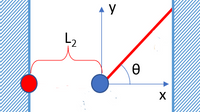
Introductory Circuit Analysis (13th Edition)
13th Edition
ISBN: 9780133923605
Author: Robert L. Boylestad
Publisher: PEARSON
expand_more
expand_more
format_list_bulleted
Concept explainers
Question
A blue charge, Q = 7.9 C with mass M = 3.8 kg, hangs from a red string of length 1.5 m as shown below. With the mass stationary, the string makes an angle of θ = 41 degrees with respect to the horizontal when a red charge q1 is brought a horizontal distance 1.2 m away. Determine the charge q1, in nC, necessary to do this

Transcribed Image Text:L2
Expert Solution
This question has been solved!
Explore an expertly crafted, step-by-step solution for a thorough understanding of key concepts.
Step by stepSolved in 2 steps with 2 images

Knowledge Booster
Learn more about
Need a deep-dive on the concept behind this application? Look no further. Learn more about this topic, electrical-engineering and related others by exploring similar questions and additional content below.Similar questions
- What will be the mobility of holes if the drift velocity of holes is 3 m/s and the applied electric field is 3 mV/m?arrow_forwardThree identical impedances Z∆ = 20\60◦ Ω are connected in ∆ to a balanced three-phase 480-V source by three identical line conductors with impedance ZL = (0:8 + j0:6) Ω per line. a) Calculate the line-to-line voltage at the load thermimals.b) Repeat part a) when a ∆-connected capacitor bank with reactance ZC = −j20 Ω per phase is connected in parallel with the load.arrow_forwardPart C onlyarrow_forward
- The figure below shows two charged particles separated by a distance of d = 1.50 cm. The charges are ₁ = -15.5 nC and 92 = 26.5 nC. Point B is at the midpoint between the two charges, and point A is at the peak of an equilateral triangle, with each side of length d, as shown. (Assume the zero of electric potential is at infinity.) d d A 60.0⁰ B d (a) What is the electric potential (in kV) at point A? kV (b) What is the electric potential (in kV) at point B? kVarrow_forwardIn Niels Bohr's 1913 model of the hydrogen atom, an electron circles the proton at a distance of 5.29 x 1011 m with a speed of 2.19 x 10° m/s. Compute the magnitude of the magnetic field this motion produces at the location of the proton. Tarrow_forwardFind V, in the circuit in Fig. 4 60,00 € ΦΩ 1:2 + Figure .4 8 Ω Το Τ ΖΩ 8 Ωarrow_forward
arrow_back_ios
arrow_forward_ios
Recommended textbooks for you
 Introductory Circuit Analysis (13th Edition)Electrical EngineeringISBN:9780133923605Author:Robert L. BoylestadPublisher:PEARSON
Introductory Circuit Analysis (13th Edition)Electrical EngineeringISBN:9780133923605Author:Robert L. BoylestadPublisher:PEARSON Delmar's Standard Textbook Of ElectricityElectrical EngineeringISBN:9781337900348Author:Stephen L. HermanPublisher:Cengage Learning
Delmar's Standard Textbook Of ElectricityElectrical EngineeringISBN:9781337900348Author:Stephen L. HermanPublisher:Cengage Learning Programmable Logic ControllersElectrical EngineeringISBN:9780073373843Author:Frank D. PetruzellaPublisher:McGraw-Hill Education
Programmable Logic ControllersElectrical EngineeringISBN:9780073373843Author:Frank D. PetruzellaPublisher:McGraw-Hill Education Fundamentals of Electric CircuitsElectrical EngineeringISBN:9780078028229Author:Charles K Alexander, Matthew SadikuPublisher:McGraw-Hill Education
Fundamentals of Electric CircuitsElectrical EngineeringISBN:9780078028229Author:Charles K Alexander, Matthew SadikuPublisher:McGraw-Hill Education Electric Circuits. (11th Edition)Electrical EngineeringISBN:9780134746968Author:James W. Nilsson, Susan RiedelPublisher:PEARSON
Electric Circuits. (11th Edition)Electrical EngineeringISBN:9780134746968Author:James W. Nilsson, Susan RiedelPublisher:PEARSON Engineering ElectromagneticsElectrical EngineeringISBN:9780078028151Author:Hayt, William H. (william Hart), Jr, BUCK, John A.Publisher:Mcgraw-hill Education,
Engineering ElectromagneticsElectrical EngineeringISBN:9780078028151Author:Hayt, William H. (william Hart), Jr, BUCK, John A.Publisher:Mcgraw-hill Education,

Introductory Circuit Analysis (13th Edition)
Electrical Engineering
ISBN:9780133923605
Author:Robert L. Boylestad
Publisher:PEARSON

Delmar's Standard Textbook Of Electricity
Electrical Engineering
ISBN:9781337900348
Author:Stephen L. Herman
Publisher:Cengage Learning

Programmable Logic Controllers
Electrical Engineering
ISBN:9780073373843
Author:Frank D. Petruzella
Publisher:McGraw-Hill Education

Fundamentals of Electric Circuits
Electrical Engineering
ISBN:9780078028229
Author:Charles K Alexander, Matthew Sadiku
Publisher:McGraw-Hill Education

Electric Circuits. (11th Edition)
Electrical Engineering
ISBN:9780134746968
Author:James W. Nilsson, Susan Riedel
Publisher:PEARSON

Engineering Electromagnetics
Electrical Engineering
ISBN:9780078028151
Author:Hayt, William H. (william Hart), Jr, BUCK, John A.
Publisher:Mcgraw-hill Education,